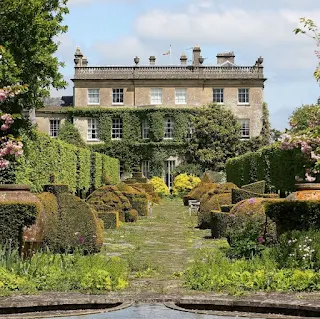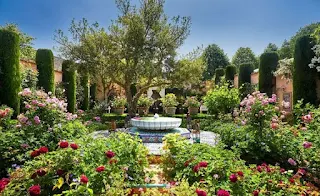 |
| Highgrove House of King Charles III |
Along with Balmoral and Sandringham, the new monarch inherited billions of assets from his mother, but some of these properties are part of the Crown Property which never goes to the private coffer of the king.
However, the Duchy of Cornwall, which he personally administered since 1969 and has been the primary source of his finances for more than 50 years, is automatically inherited by his eldest son and heir, Prince William, who assumed the Duke of Cornwall title upon the death of the Queen.
The Duchy of Cornwall
The Duchy of Cornwall covers 52,449 hectares of land across 20 counties, mostly in the South West of England. It comprises land and livestock farms, residential and commercial properties, as well as forests, rivers, quarries, and coastlines.
It is a private estate administered by the Duke of Cornwall or the eldest son of the British sovereign, and one of the two royal duchies in the United Kingdom, the other one is the duchy of Lancaster.
 |
| Father and son at Home Farm |
The Duchy of Cornwall's revenue provides income to the Prince of Wales, and paid his public and private activities, including the salaries and wages of his staff. When Charles was still the heir apparent, the allowances and activities of Prince William and Prince Harry, and their respective wives, and the salaries and wages of their staff are paid from the income of the duchy.
The duchy's property portfolio is estimated to be around £345million with land holdings in England, Cornwall, Devon, Herefordshire, Somerset, almost all of the Isles of Scilly, the Home Farm in Highgrove, and the Highgrove House in Gloucestershire. In 2021, the duchy has a net income of £21million.
 |
| Isles of Scilly in Cornwall |
All of these assets and properties are now in the care of Prince William, the Prince of Wales, and the current Duke of Cornwall. The duchy's revenues are now the primary source of his income that would finance his and Catherine's activities, charitable works, and their staff.
It further means that Prince William will have to collect rent from his father for residing in Highgrove House, and from the tenant of Home Farm, a sustainable organic farm near Highgrove that King Charles developed in 1985.
 |
| The Prince and Princess of Wales with their young sons, William and Harry in Highgrove |
In 1980, then Prince of Wales, Charles, bought the Highgrove estate (including the house and the surrounding farmland) using his income from the duchy of Cornwall. But it could not be privately owned by him as it automatically became properties of the duchy.
Despite being the Duke of Cornwall who controlled and managed the duchy, he does not have the right to sell any assets related to the duchy nor claimed it as his own. All of its properties must be inherited by the next Duke of Cornwall.
 |
| The spectacular Highgrove gardens |
As the Highgrove estate became part of the investment portfolio of the Duchy of Cornwall, Prince Charles entered into an agreement to lease the estate.
 |
| While still the Prince of Wales, Charles personally tended home farm in Highgrove |
In 1985, he developed the nearby farmland of Highgrove (1,000 acres) and converted it into sustainable farming using agricultural innovation that's environmental friendly.
Highgrove's home farm has been producing organic farm products since 1990 under the label, Duchy Originals Limited, it entered into a partnership with Waitrose, now known as Waitrose Duchy Organic.
 |
| The Prince of Wales at his Highgrove gardens |
In 2020, as Prince Philip fully retired from being the Queen's administrator of her estates (Balmoral, Sandringham, and Windsor), Prince Charles took over the management and began developing the Sandringham estate into an organic farm.
The same year that the future king did not renew his 20-year lease of the Home Farm in Highgrove because of his future role as monarch. The Home Farm was eventually leased by another individual which the Royal Family declined to name. The new tenant, who is a non-royal, will continue to produce organic farm products for Waitrose Duchy Organic.
 |
| King Charles III at his Highgrove gardens |
King Charles retained his lease agreement for his Highgrove home. Upon his accession to the throne, Prince William inherited the Duchy of Cornwall along with its investment portfolio and became its primary administrator. Now, his father must pay him an annual rent of £700,000 for his Highgrove residence.
History of the Duchy of Cornwall
The Duchy of Cornwall was originally established through the Royal Great Charter by King Edward III on March 17, 1337, for his son, Edward, Prince of Wales, also known as the "Black Prince".
It was formerly an earldom before it was elevated into dukedom. The Black Prince became the first Duke of Cornwall. King Edward III, who founded the Most Noble Order of the Garter, the highest chivalric honor in Britain, established that the Duke of Cornwall should be the eldest surviving son of the monarch and the heir to the throne.
Charles became Duke of Cornwall in 1952 when he was only three years old, he did not fully assume the responsibilities of the duchy until he turned 21 in 1969. He is the longest-serving Duke of Cornwall in history. But the Duke of Cornwall cannot sell assets from the duchy for personal benefits.
The Duchy of Cornwall is exempted from paying corporation tax as the government considers the duchy to be a crown body, however, Prince Charles decided to voluntarily pay taxes beginning in 1993 after some members of the parliament questioned its validity of tax exemption.
Since 2011, revenues of the Duchy of Cornwall directly passed to the heir to the throne regardless of whether the heir is the Duke of Cornwall. During King Charles III's time as Duke of Cornwall, the revenues he received from the duchy also financed the activities of the Duke and Duchess of Cambridge and the Duke and Duchess of Sussex, and also provided their allowances.
The Highgrove Estate
Located in Tetbury, Gloucestershire, Highgrove is surrounded by the sweeping greenery of nature. It has a nine-bedroom Georgian mansion designed into a neo-classical building. Diana, the Princess of Wales took charge of the interior furnishing during the early years of their marriage.
 |
| Highgrove house |
The Highgrove estate is King Charles III's private oasis. It has been his favorite residence since 1981 and had devoted much of his time to developing it into a sustainable country home. It is being run according to his environmental principles with solar panels installed and zero waste machinery.
Highgrove has stunning royal gardens, adorned with scented flowers like wisteria, jasmine, honeysuckle, and thyme. Wild meadows with native wildlife, arboretum, where varieties of beech and cherry trees grow, magnolias, and other seasonal blooms can be found in the gardens. The Highgrove gardens have guided tour packages every season.
 |
| Highgrove gardens |
There’s also The Stumpery inspired by Victorian gardening techniques, an oak temple, and a cottage garden inspired by the colors of Tibet. Apart from exploring the Royal Gardens, visitors can also enjoy a Highgrove cream tea in the opulent Orchard Tea Room, which offers a range of artisan goodies.
Read more about Highgrove Estate and Gardens here
 |
| Prince William and Prince Charles surveying the home farm |
Highgrove estate and the Duchy of Cornwall largely credited King Charles for what these properties became today: "sustainable, financially viable and of meaningful value to the local community”. He was also behind the creation of Poundbury, a village near Dorchester in Dorset, which became the model of sustainability.
 |
| Poundbury in Dorset |
His environmental crusade, interest in architecture, agricultural innovation, sustainability, and organic farming principles, shaped the Duchy of Cornwall properties into valuable and environmental-friendly properties. The question many now asked will his son and heir, Prince William, continue to follow his environmental principles in running the duchy?










0 Comments